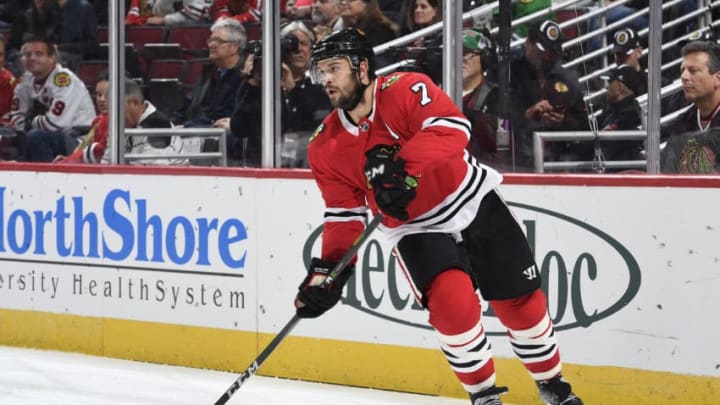The Chicago Blackhawks took a huge risk by extending defenseman Brent Seabrook for eight years back in 2015. Though the ink on the contract is barely dry, it’s already hurting the team.
Part of being an NHL general manager is evaluating risks and minimizing them. Few GMs are better than Stan Bowman of the Chicago Blackhawks. He’s put together a core that has brought three Stanley Cups to the Windy City. The Blackhawks are consistent contenders because of them. Bowman is forced to navigate the perils of the salary cap but has generally done well.
But as any general manager will tell you, all it takes is one huge mistake to sink your ship. Bowman has probably made his already, in the form of defenseman Brent Seabrook. Back in September of 2015, he was going into the last year of his contract. Seabrook was a big part of their three Stanley Cup titles, so Bowman believed he had to keep him.
More from Puck Prose
- Detroit Red Wings 2023 Rookie Camp Has Plenty of Ups and Downs
- This Columbus Blue Jackets rookie doesn’t want to be forgotten
- 2 trades the Boston Bruins must make to secure the Stanley Cup
- 3 reasons the Avalanche won’t win the Stanley Cup in 2024
- This is a big year for Alex Turcotte and the Los Angeles Kings
He got signed to an eight-year extension, which went into effect at the beginning of the 2016-17 season. Entering the deal, Seabrook was 31 years old, making the extension a significant risk.
However, Bowman’s best guess was that the 2010 Olympic gold medalist would remain a good defenseman for at least the first three or four years of the deal.
Turns out he was off by two years. And not in a good way. Seabrook’s decline has begun, and it’s already getting pretty ugly. His extension affects the Blackhawks negatively, both on and off the ice.
On The Ice
Seabrook wasn’t a great possession skater, even in his prime. He’s certainly known for being productive, but his impact on shot attempts has usually been on the negative end. From 2007-08 to 2014-15, Seabrook’s relative CorsiFor percentage at even strength was -1.3 percent. But considering the heavy minutes he played (at least 20 minutes per game each season) and his close to breaking even expected goals differential of -0.03 per 60 minutes, on top of his fairly consistent production, his possession deficiencies were justifiable.
However, Seabrook’s numbers started getting ugly before the extension even went into effect. Since the start of the 2015-16 season, he has a -5.5 percent relative CorsiFor percentage at even strength, on top of a -0.45 expected goals differential per 60 minutes and a -21 penalty differential. Even though Seabrook has actually seen a slight uptick in production during this time and he’s still averaging over 20 minutes a game, his possession numbers are alarming.
But even if you don’t like the numbers, you don’t need them to see the decline. Plays like this one have been something Seabrook has always been subject to, as he’s never been known for his speed skating. But now these plays are far more common.
Seabrook in the defensive zone pic.twitter.com/RagJmX25Dw
— Hoop Informatics 🏀📊🎥 (@HoopInformatics) November 13, 2017
There are two ways to look at this. You can either see Seabrook’s declining possession numbers and be worried. Or you can take the glass-half-full approach and take solace in his increased production. But regardless, considering it’s year two of an eight-year extension with a no-movement clause through the 2021-22 season, Blackhawks fans can’t be too optimistic about his future.
Off The Ice
Now here’s where the Blackhawks EXPECTED for it to hurt them. It’s never good to be committing nearly $7 million a year to a defenseman over 30 years old. But Seabrook’s extension has already hurt them in several ways.
Let’s start with the first way it did. During the 2015 offseason, the Blackhawks pretty much had to choose between keeping Brandon Saad or Seabrook. Bowman chose the latter. The former got shipped to the Columbus Blue Jackets. Of the pieces involved in the trade, only Artem Anisimov remains in Chicago.
It’s worth noting the Blackhawks brought Saad back. This shows they probably didn’t want to part with him in the first place. Looking at the 2015 free agents, Mike Green or Andrej Sekera could have been a Seabrook replacement, assuming the Hawks traded him. Even if they simply let him walk during the 2016 offseason, Jason Demers could have been a decent replacement.
Secondly, it’s hard to tell if the Blackhawks would have been able to hang onto both Artemi Panarin and Saad without Seabrook. Especially if they would have signed Green or Sekera. Even if they wouldn’t have, maybe they would have traded Panarin for a great young defenseman.
The Seabrook contract will continue to hurt the Blackhawks as well unless he starts trending upward again. But once defensemen start their decline, while there might be a few hills, there are mostly descents and valleys. Seabrook’s still productive, but if that leaves him, that will further decrease his already declining value.
Next: 3 Bold Predictions For The Blackhawks
Bowman’s a darn good general manager. But whether it’s fair or not, he deserves criticism for taking a very bad risk in Seabrook. Especially since it’s just year two of the eight-year deal. Though Bowman might never admit it, privately, he’d likely love a mulligan on Seabrook’s extension.
Unless otherwise noted, all data is courtesy of Corsica.
